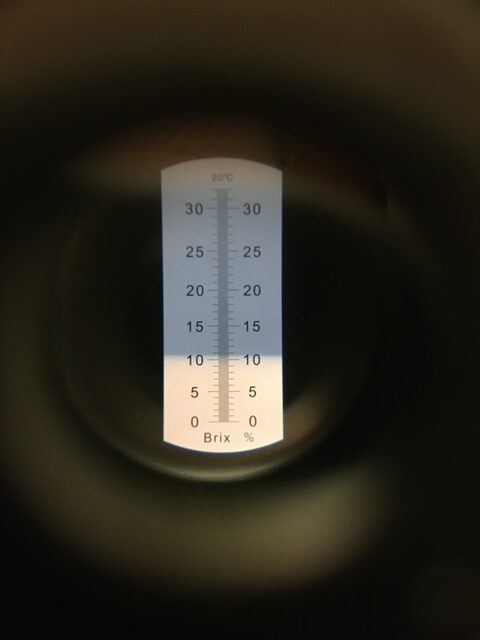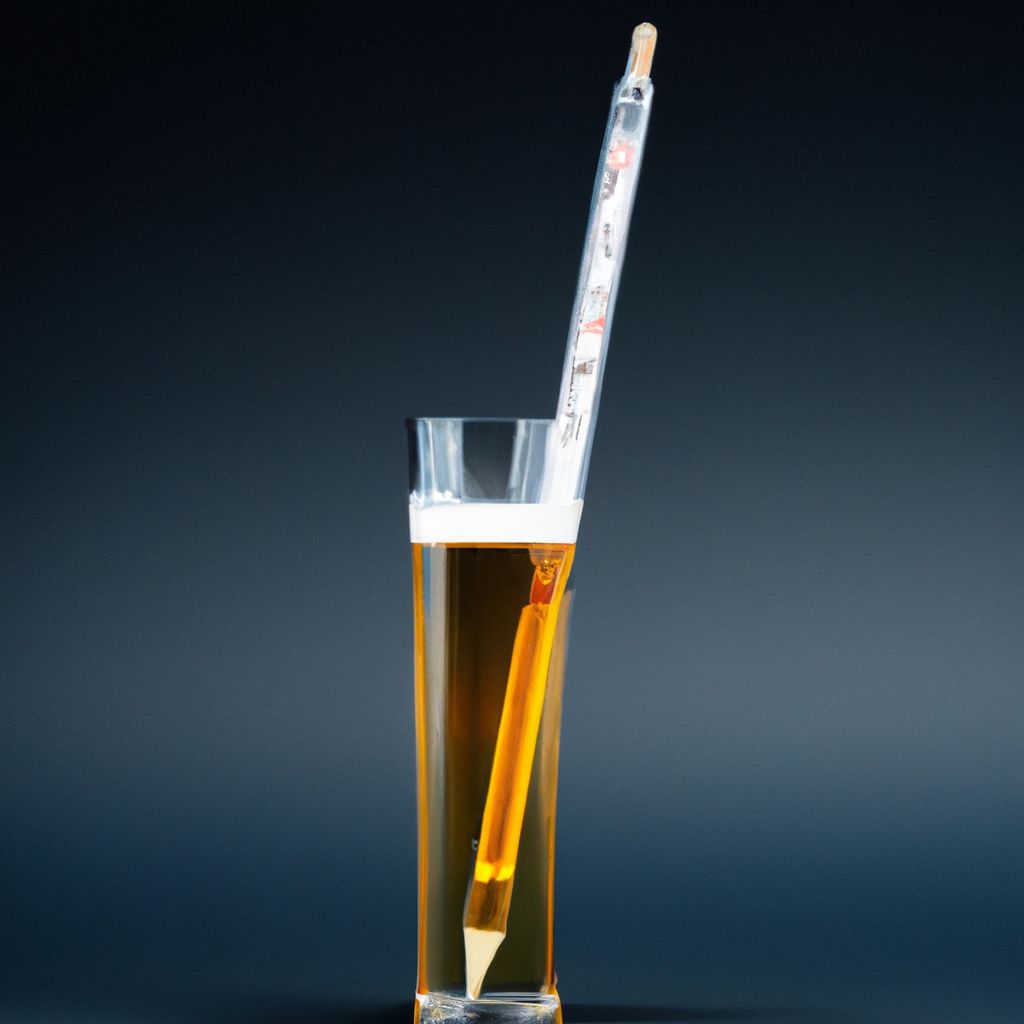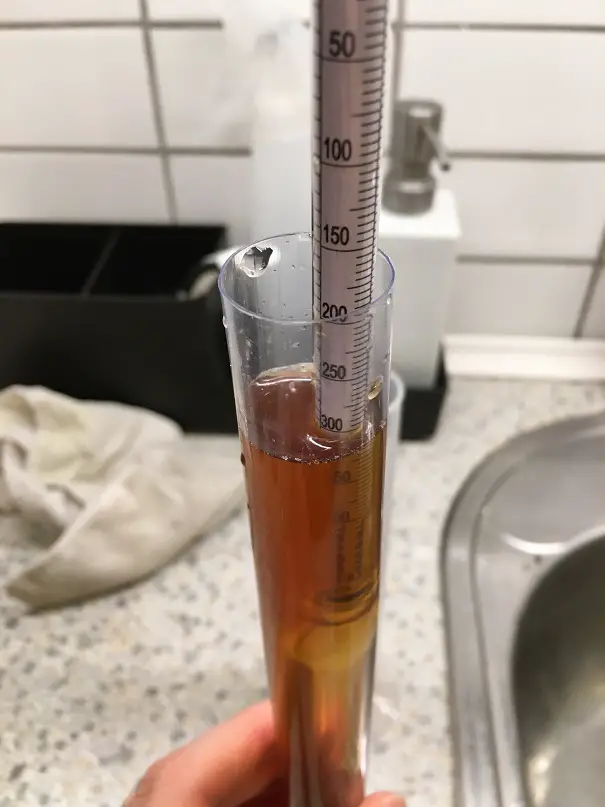Brix is a way to measure the sugar content in liquids like wort or juice. It’s expressed as a percentage of weight, with water being 0°Bx. This helps brewers figure out how much alcohol is in their beer.
SG stands for Specific Gravity. It’s a measure of density compared to water. Brewers use it to track fermentation progress and calculate alcohol content.
Plato is another unit used to measure sugar levels. Like Brix, it’s a percentage by weight. But, it doesn’t account for temperature changes. Plato is often used in commercial brewing.
Brix and Plato can be swapped when measuring sugar content. There is no “gold standard” and it all depends on what you prefer.
Remember: All methods are sensitive to the alcohol content of the brew, as we will discuss at the end of this post!
Understanding Brix, SG, and Plato in brewing
Brewers take accuracy seriously! Brix measures the sugar content of liquids through refractive index. SG shows the density of a liquid compared to water.
And Plato is the percentage by weight of dissolved solids in a liquid.
To convert between these measurements, formulas are used. For example, Brix to SG can be calculated with this equation:
SG = (Brix / (258.6 – ((Brix / 258.2) * 227.1))) + 1.
To get accurate readings, it’s best to use a refractometer or hydrometer. Sing ‘Sweet Home Accuracy’ – that’s what brewers do!
Importance of measuring Brix, SG, and Plato in brewing
Why do we keep buying more craft beer when our fridge is already overflowing? Measuring Brix, SG, and Plato in brewing is just as confusing!
It’s crucial, though, for ensuring the quality and consistency of beer production. These measurements tell us about the sugar content of the wort – essential for fermentation and alcohol level.
Let’s explore some key aspects of Brix, SG, and Plato:
Metric: Brix
Purpose: Measures sugar content in a liquid sample. Helps brewers determine potential alcohol yield after fermentation.
Metric: SG
Purpose: Specific Gravity (SG) shows density compared to water. Tracks sugar conversion during mashing, and predicts fermentation outcomes.
Metric: Plato
Purpose: Expresses sugar concentration as a percentage by weight. Gives insight into wort composition, accounting for proteins and minerals.

These metrics are useful for taking necessary actions at each stage of brewing. Here’s how to leverage the knowledge:
- Optimize Fermentation: Monitor Brix or SG before and after. Ensure optimal yeast activity.
- Assess Wort Extraction: Track Brix during mashing. Adjust processes accordingly.
- Determine Beer Style & Flavor: Use Plato readings to calculate final gravity. Fine-tune recipes for specific styles.
- Ensure Batch Consistency: Measure metrics consistently across batches. Detect any deviations early on.
Brewing artisans can use this knowledge to gain greater control over their beer production. Accurate measurement of Brix, SG, and Plato is essential for consistently delivering remarkable brews.
How to measure Brix, SG, and Plato in brewing
In beer brewing, it’s essential to put numbers to your craft. To understand the techniques involved in measuring Brix, SG, and Plato, here’s a breakdown:
| Brix Measurement: | Sugar content in a solution is measured using a refractometer. It gives brewers info about the potential alcohol level. |
| Specific Gravity (SG) Measurement: | A hydrometer is used to determine the density of a liquid compared to water. This helps calculate alcohol content during fermentation. |
| Plato Measurement: | The weight of fermentable extract in a solution is calculated as a percentage. Brewers use Plato meters, which are specialized hydrometers, to obtain this measurement. |
Modern breweries have digital refractometers and software for greater accuracy and convenience when analyzing these parameters.
Milwaukee MA871 Refractometer

Fastest and Most accurate
Best digital handheld Refractometer
- Less than 2 second readout
- Feels sturdy and robust
- Easy to clean and calibrate
- 0-85% measurement range
Mastering these measuring techniques is key for perfectly balanced beer and desired alcohol content. Get the best results by not neglecting these steps!
How it’s actually done:
Brix, specific gravity (SG), and Plato are all measurements used in brewing to determine the sugar content and potential alcohol content of a liquid. Here’s how you can measure each of them:
- Brix:
- Brix is a measurement of the sugar content in a liquid. It represents the percentage of sugar by weight in a solution. To measure Brix, you need a refractometer specifically calibrated for Brix measurements.
- Start by taking a sample of the liquid you want to measure. It could be wort, must, or any other liquid involved in the brewing process.
- Using a pipette or dropper, place a few drops of the liquid onto the prism of the refractometer.
- Close the cover of the refractometer and look through the eyepiece. You will see a scale with a reading in Brix units.
- Take the reading where the line of demarcation crosses the scale and record the value. This will give you the Brix measurement of the liquid.

- Specific Gravity (SG):
- Specific gravity is a measurement of the density of a liquid compared to the density of water. In brewing, it is commonly used to determine the sugar content and the potential alcohol content of the liquid.
- To measure SG, you need a hydrometer. Make sure the hydrometer is properly sanitized before use.
- Take a sample of the liquid you want to measure in a tall and narrow container, such as a graduated cylinder or a specialized hydrometer test jar.
- Place the hydrometer gently into the liquid, making sure it is floating freely and not touching the sides of the container.
- Take the reading at the point where the hydrometer’s surface intersects with the liquid. The scale on the hydrometer will indicate the specific gravity.
- Record the SG reading, which may be a decimal number (e.g., 1.050).

- Plato:
- Plato is measured in the same way as SG.
- Plato is directly related to the amount of dissolved solids in the liquid and represents the percentage of sugar by weight.
- You can calculate Plato using the SG measurement with the following formula: Plato = (-463.37) + (668.72 × SG) – (205.35 × SG^2).
- Once you have the SG reading, plug it into the formula to calculate the Plato measurement.
Remember to consult the specific instruments you are using for any additional instructions or calibrations required. These measurements are valuable for tracking the fermentation process, estimating alcohol content, and adjusting recipes in brewing.
Applications of Brix, SG, and Plato in brewing
Brix, SG, and Plato are important for brewing. We can use a table to see their practical applications:
| Sugar Measurement | Abbreviation | Purpose |
|---|---|---|
| Brix | °Bx | Sugar content before fermentation. |
| Specific Gravity | SG | Density and alcohol potential. |
| Plato | °P | Dissolved solids content. |
Brewers use these measurements throughout the process. Brix helps them know the initial sugar before fermentation. SG reveals the progress and alcohol levels. Plato evaluates maltiness and body.
In conclusion, Brix, SG, and Plato are helpful. Brewers use them to measure sugar, monitor fermentation, and analyze composition. Calibrating hydrometers or refractometers is key for accurate readings. Warning: head-scratching may occur. A cold beer is highly recommended.
Limitations and considerations when using Brix, SG, and Plato in brewing
Limitations and considerations arise when using Brix, SG, and Plato in brewing. It is essential for brewers to understand these factors to get accurate measurements and reach desired outcomes. Here’s a summary of the key points to keep in mind when using these measurements in the brewing process:
A Table showing the Limitations and Considerations of Brix, SG, and Plato in brewing:
| Measurement | Limitations | Considerations |
|---|---|---|
| Brix | Temp variations skew readings | Compensate with temp-correcting devices |
| SG | Errors on hydrometer readings | Calibrate hydrometer for precision |
| Plato | Inaccuracies from impurities | Avoid impurities affecting density |
These measurements have their own distinct attributes not discussed previously. For instance, Brix measurements can be affected by temperature changes, thus needing temp-correcting equipment for correct readings.
Additionally, specific gravity (SG) readings with hydrometer are vulnerable to mistakes if not calibrated properly. Lastly, impurities present while taking Plato readings can affect density calculations, so it is essential to have a pure sample.

The story of the usage of Brix, SG, and Plato in brewing is fascinating. As time went by, dedicated brewers have improved these measuring techniques to achieve greater precision in their craft.
Thanks to the collective effort of those before us, modern brewers can now benefit from more reliable instruments and methods for gauging fermentation stages precisely.
Brewing may be scientific, but after learning about Brix, SG, and Plato, I think I need a drink to forget all the numbers!
How sensitive are each method to the alcohol content?
The sensitivity of Brix, Specific Gravity (SG), and Plato measurements to alcohol content varies depending on the method used and the specific instrument employed. Let’s consider the sensitivity of each method individually:
- Brix: While Brix measurements are primarily used to estimate sugar content, they can be affected by alcohol presence. Alcohol has a slightly different refractive index compared to water and sugars, which can lead to deviations in Brix readings. However, the effect of alcohol on Brix measurements is generally minimal in the typical alcohol ranges found in fermented beverages. For more accurate alcohol measurements, using other methods such as distillation or specific alcohol testing instruments is recommended.
- Specific Gravity (SG): SG is sensitive to changes in sugar content and alcohol presence. As the fermentation process converts sugars to alcohol, the SG of the liquid decreases. However, the alcohol content itself does affect the SG measurement. Typically, the effect is relatively small, especially at lower alcohol concentrations. But as the alcohol content increases, it can impact the accuracy of the SG measurement. In such cases, more specialized instruments like densitometers may provide more precise measurements.
- Plato: Similar to Brix, Plato measurements can be influenced by the presence of alcohol due to variations in refractive indices. However, the impact of alcohol on Plato readings is generally minimal within the typical alcohol ranges found in fermented beverages.
In summary, while alcohol can have a minor effect on Brix, SG, and Plato measurements, the influence is usually not significant within the typical alcohol concentrations found in fermented beverages. However, for precise and accurate alcohol measurements, it is recommended to use specialized alcohol testing methods or instruments specifically designed for alcohol quantification.
Conclusion
We finished learning about Brix, SG, and Plato in brewing. They are vital for gauging sugar content and fermentation potential. Brewers must understand them to get consistent outcomes and beers with desired traits.
But, Brix, SG, and Plato aren’t the same. They have their own formulas and scales. To be sure of calculations, get a reliable hydrometer or refractometer. They will help track fermentation and get recipes just right.
I wish you Brewing success!




